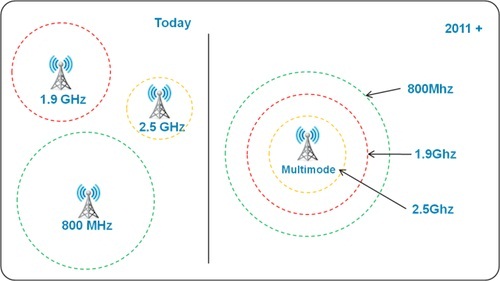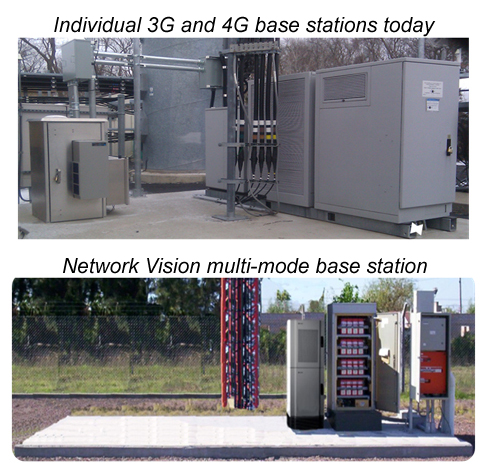Clearwire's future LTE network and the equity funding it needs to build it
 by Robert Herron
by Robert Herron
Sprint 4G Rollout Updates
Tuesday, December 6, 2011 - 10:39 AM MST
On Monday, Clearwire announced it is planning on offering up two sales of new common stock to raise up to an additional $345 Million in new funding to help build out it's planned TD-LTE network on it's 2500MHz spectrum.
Last week, Sprint and Clearwire announced a new funding plan in which Clearwire would receive up to $1.6 Billion in new monies from Sprint Nextel. However, to get all that funding, Clearwire had to meet several milestones and other requirements. Also, separately Sprint offered up an additional $347 Million in additional equity funding. But in order to get those additional funds from Sprint, Clearwire had to find other equity sources to match Sprint's offer. Because Sprint does not want to change it's ownership percentage in Clearwire to be greater than 49.6%. So new equity funding in the these new sales would be matched with Sprint equity funding to maintain the 50.4%/49.6% ratio.
Clearwire to focus equity funding on LTE build out
Should the sales be successful and Clearwire receive the maximum funding possible from Sprint, Clearwire says that they intend to use these new equity funds to begin building out a LTE network in 2012. Clearwire has tentatively stated that their LTE plans begin with adding 20MHz TD-LTE carriers at existing WiMax deployed areas. But before you get excited, this almost certainly does not include WiMax protection sites.
In most markets, Clearwire has said it is a rather simple upgrade to convert their towers to LTE. But the work involved to convert base stations is more difficult and expensive in the early WiMax markets (like Portland). However, what has not been simple to date for Clearwire has been funding. They are hoping this will be the solution to their short term funding problems.
Also, there have been rumors that Clearwire will reduce the number of WiMax carriers from three to one in places they add LTE. But Clearwire has yet to comment on this directly. But this could cause significant WiMax congestion in many urban areas, if true.
Sprint to use Clearwire LTE to enhance it's LTE network
It's of great importance to note that Sprint's deal with Clearwire for LTE is for increased capacity on top of Sprint's LTE. Sprint is currently rolling out it's own FD-LTE on 1900MHz PCS G-Block with it's Network Vision upgrades. And will add an additional FD-LTE carrier on it's 800MHz spectrum as soon as the Nextel iDEN network is transitioned off in 2013. Sprint LTE deployment is already under way and the first tower went live in Branchburg, New Jersey yesterday.
Sprint's LTE is completely independent of Clearwire's LTE network. Sprint's LTE network is planned to go over it's entire CDMA footprint. Clearwire's network is not planned to ever be so extensive (unlike the aspiring plans of it's WiMax network). And Sprint will not be dependent on it to be extensive. Sprint will use it's own LTE network to be the mobile broadband workhorse, where most of the traffic will run. It will only use Clearwire in places additional capacity is needed. Clearwire will almost certainly not have a LTE market covered that Sprint doesn't.
Clearwire is focusing it's LTE build out in two ways. First, to add LTE service to it's existing WiMax network. Probably starting with the largest and most dense markets first. Clearwire may not even try to get LTE over it's entire WiMax coverage area. Instead, just focusing on primary and strategic secondary markets. Places where their wholesale business model will pay off most. I could see them not caring much about places like Abilene, Texas and Modesto, California, etc.
Second, Clearwire has committed with Sprint to focus on adding it's TD-LTE on Network Vision towers when and where additional capacity is needed. This will also most likely be in primary and dense secondary markets. This part is very good news for Sprint customers. Provided that Sprint monitors the network in a proactive manner, this will mean that Sprint's LTE should never suffer from consistent capacity issues. Even if unlimited smartphone data remains.
How Sprint will utilize Clearwire TD-LTE network with it's own FD-LTE
Here are some examples of how the combined LTE network deal would work. Let's say you live in Downtown San Diego. In 2012, Sprint shows up with LTE service on 1900MHz. You get good speeds and service from day one. And slowly over time Sprint sells more and more devices to customers in your cell. In approximately 12 months or so, the 5x5 FD-LTE carrier you use in Downtown San Diego starts to have reduced performance beyond what the highly sophisticated LTE network can mitigate.

But now Sprint deploys it's 800MHz 5x5 FD-LTE carrier on your tower. And between the two carriers, LTE capacity has doubled. And Sprint adds more and more LTE customers. In another year, the two carriers start reaching capacity, so Sprint asks Clearwire to add a TD-LTE carrier to that tower for more capacity. In another two years, that site starts reaching capacity again, and Clearwire adds another TD-LTE carrier. In many markets, Clearwire can add 5 or more 20MHz TD-LTE carriers. Clearwire will likely only add them at Sprint's request, one base station at a time, as Sprint needs them.
Also of note, is that even at towers where Sprint adds Clearwire LTE service for capacity, Sprint customers will likely only be using it when the 800/1900 LTE is maxing out. Like during the evenings. During the day you may be on 800 in your basement and 1900 in your Living Room. But in the evening, you may transition to Clearwire 2500 in your Living Room. But the network controls and your device will make the experience seamless to customers. You just see the same 4G icon and maybe with some minor signal strength variability.
Now take this to suburban Indianapolis. Maybe the initial two Sprint LTE carriers don't bog down for three years. But when they do, Clearwire comes in adding carriers tower by tower where additional LTE capacity is needed. And given Sprint's Network Vision architecture, these adds will be relatively inexpensive. And everything should be set up in advance to add them easily and quickly.
And in tertiary and rural markets, Sprint will likely never need to add Clearwire TD-LTE carriers to their towers. The 1900MHz will cover most of them sufficiently. But even the ones who eventually get strained on 1900, Sprint's 800MHz FD-LTE carriers will be deployed by the time they would experience any performance loss.
Exciting times for Sprint and Clearwire. The only things between them and these future LTE successes is money. But incrementally, this appears to be working out more and more. Let's all hope Clearwire can raise the paltry $350 Million to get Sprint's matching equity bucks.








1 Comment
Recommended Comments